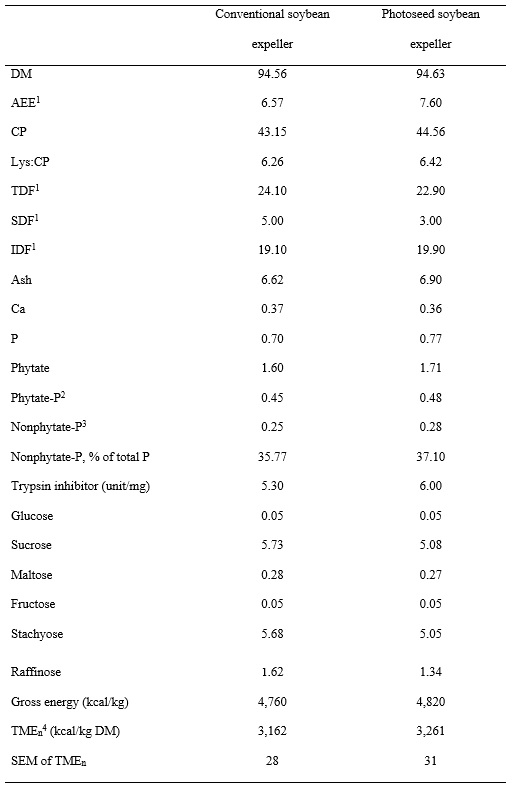The improvement of yield or oil content in soybean seeds, mainly through genetic modification, has often resulted in a decrease in protein concentration. However, a new genetic technology patented as Photoseed was used to develop a new variety of soybeans. By modifying genes involved in biosynthesis and storage of lipids, it was possible to increase the accumulation of lipid droplets and increase carbon capture. This resulted in soybeans that contain more oil, without negatively affecting crude protein concentration, compared with conventional soybeans. There is, however, no information about the nutritional value of the soybean meal produced from the Photoseed variety of soybeans. Therefore, the objective of this study was to test the hypothesis that nitrogen-corrected true metabolizable energy (TMEn), standardized amino acid (AA) digestibility, and apparent ileal P digestibility are not different in a soybean expeller (SBE) produced from a new variety of Photoseed soybeans compared with SBE produced from conventional soybeans.
Material and methods
Two samples of conventional and Photoseed soybeans were procured from Zeakal Inc. (San Diego, Ca, USA). The beans were extruded and expelled at Insta Pro (Grimes, IA, USA) to produce SBE from each source of soybeans.
In Experiments 1 and 2, two precision-fed rooster assays were conducted to determine TMEn and standardized AA digestibility in conventional and Photoseed SBE using conventional and cecectomized roosters, respectively. For each experiment, six replicate White Leghorn roosters were fasted for 26 h and then tube fed 25 g of each SBE, and excreta samples were collected for 48 h post-feeding. Data were analyzed using one-way ANOVA for a completely randomized design. Differences between treatments were considered significant at P < 0.05.
In Experiment 3, an ad-libitum-fed broiler chicken assay was conducted to determine apparent ileal P digestibility in conventional and Photoseed SBE. Eighty commercial Ross 308 male chicks were fed a standard corn-soybean meal diet from 0 to 16 d of age and birds were then fed diets containing one of the SBE as the only source of P from d 17 to 21. The 2 experimental diets had a Total Ca:Total P ratio of 1.4:1 and TiO2 was used as a digesta marker. There were 5 chicks per pen and 8 replicate pens per treatment and the pen was the experimental unit. On d 21, chicks were euthanized and ileal digesta were collected. Data were analyzed as in Experiments 1 and 2.
Results and discussion
Similar values were observed in the nutritional composition between the two SBE sources but slightly greater values for total concentration of AA were observed in Photoseed SBE compared with the conventional (Table 1).
Results from Experiment 1 yielded TMEn values of 3.162 and 3.261 kcal/g DM for the conventional SBE and Photoseed SBE, respectively, with the value being greater (P < 0.05) for Photoseed SBE (Table 1).
Results from Experiment 2 showed standardized digestibility of most AA of approximately 90%, and there was no difference between the two SBE. However, Photoseed SBE had greater (P < 0.05) concentrations of digestible Arg, Lys, Phe, Trp, and Val compared with conventional SBE (Table 2).
Results from Experiment 3 indicated values for apparent ileal P digestibility of 46.8% and 40.6% for conventional SBE and Photoseed SBE, respectively, and these values were not different (Table 3).
In summary, TMEn was greater in Photoseed SBE compared with conventional SBE, but digestibility of AA and P was not different although Photoseed SBE had greater digestible concentrations of some indispensable AA compared with conventional SBE. Results of this study indicated that the nutritional value of Photoseed SBE is not less than in conventional SBE when fed to chickens.
Key points
- Photoseed SBE have equal or greater nutrient concentration compared with conventional soybean meal.
- TMEn is greater in Photoseed SBE compared with conventional SBE.
- No differences in digestibility of AA or P between the Photoseed and conventional SBE.
- Greater digestible concentrations of some indispensable AA in Photoseed SBE compared with conventional SBE.
Table 1. Analyzed composition of two sources of soybean expellers, as-fed basis

1AEE = acid-hydrolyzed ether extract; TDF = total dietary fiber; SDF = soluble dietary fiber; IDF = insoluble dietary fiber.
2Phytate-P was calculated by multiplying the analyzed phytate by 0.282 (Tran and Sauvant, 2004).
3Nonphytate-P was calculated as the difference between total P and phytate-P.
4TMEn values were significantly different (P < 0.05). TMEn values are means from 6 individually-caged conventional roosters (Experiment 1).
Table 2. Standardized amino acid digestibility of soybean expellers, Experiment 21.
1Values are means of 6 individually-caged cecectomized roosters. There were no significant differences (P > 0.05) between digestibility values for the 2 soybean expellers. P-values for digestible concentration of Arg, Lys, Phe, Trp, and Val were significant.
2Digestible concentration = (total x standardized digestibility values)/100.
3SEM for standardized digestibility values.
Table 3. Apparent ileal P digestibility values of soybean expellers for broiler chicks in Experiment 31.
1Values are means of 8 pens of 5 chickens from 18 to 21 days of age for weight gain, feed intake, and gain: feed ratio. Ileal P digestibility values are at 21 days of age.